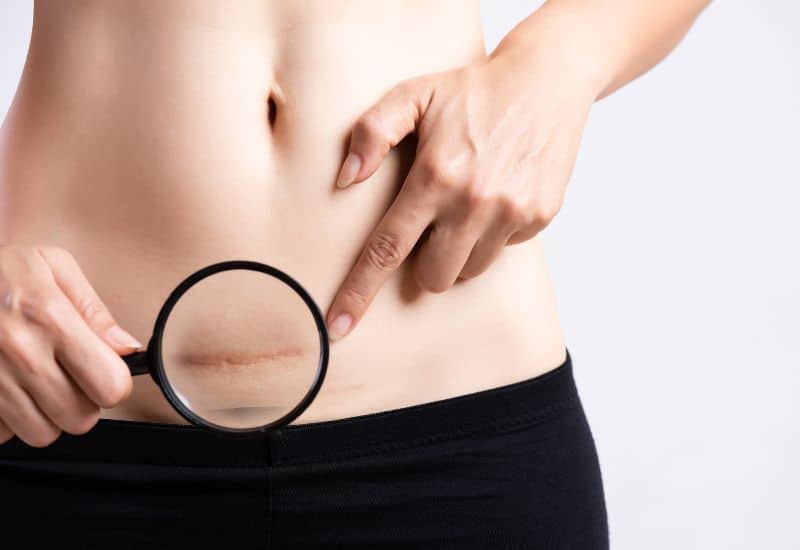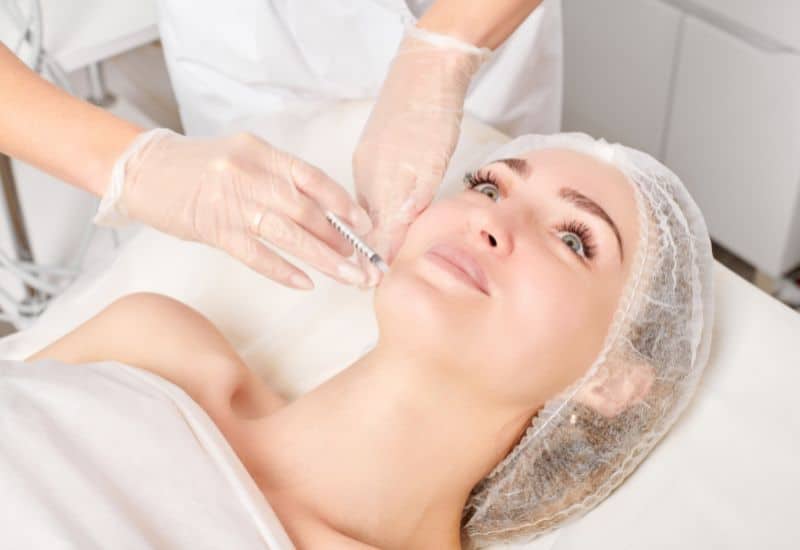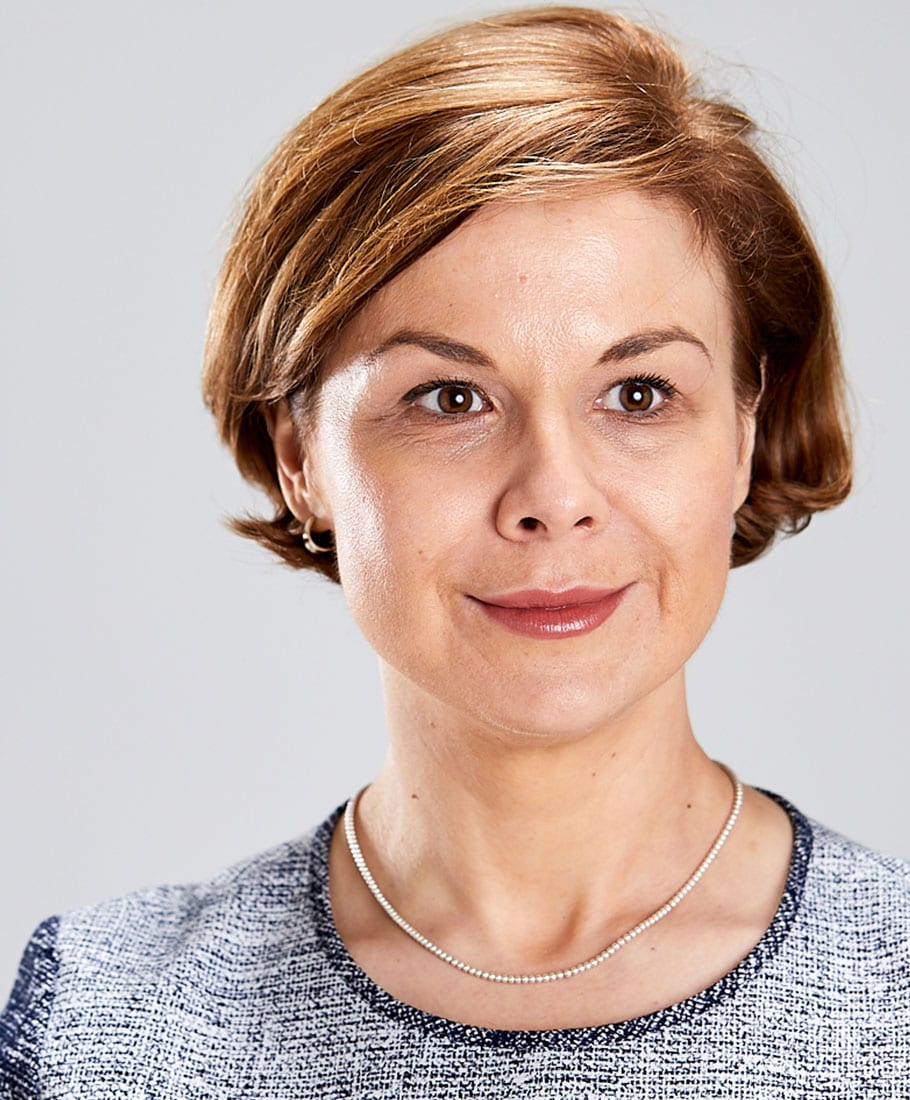Procedures
Scar Revision

Everyone gets scars. Perhaps you got one from a childhood bicycle fall or from a recent accident or surgery. However, while some scars are small and easily hidden, others can be large, visible, and possibly a source of discomfort. A scar is more than just a physical mark; it can also significantly affect the way a person feels about themselves. For some, it is a constant reminder of an unpleasant past event. It can be hard to move on when a part of your past is visibly etched on your body. This is where scar revision surgery steps in. It’s not about completely erasing your past, but rather, helping you embrace your future with less physical evidence of what has been. It is important to note that no scar can be completely removed. The goal of scar revision is to make the scar less conspicuous, not to remove it altogether.
Chester Consultant Plastic Surgeon Anca Breahna performs scar revision surgery, as well as other face, body and skin procedures.
At a glance
30 - 60 minutes
Local anaesthetic
48 hours
Improved scar appearance
Table of Contents
What is Scar Revision Surgery?
Scar revision surgery is a surgical procedure aimed at improving the appearance of scars, as well as restoring function, and correcting disfigurement caused by an injury, wound, or previous surgery. It involves altering the appearance of the scar to make it less noticeable and blend more seamlessly with the surrounding skin. This often involves reducing the size of the scar, changing its shape or colour, or reorienting its direction.
Scar revision surgery is done by a plastic surgeon and may be performed in a hospital, an outpatient surgical facility, or in your surgeon’s office, depending on the extent of the surgery required. It might be done under local or general anaesthesia, depending on the size, location and number of scars.
It’s important to have a clear understanding of what the surgery can achieve. While scar revision surgery can help to improve the appearance of a scar, it can’t make it disappear completely.
Who Needs Scar Revision Surgery?
Scar revision surgery is designed to improve the appearance of scars and may not be suitable for everyone. The following factors are often considered when evaluating whether a person is a good candidate for this procedure:
- Good General Health: A person who is in good health is a suitable candidate. Good health ensures that the body can heal properly after surgery
- No Serious Medical Conditions: Chronic or uncontrolled medical conditions may interfere with healing. These need to be managed effectively before considering surgery
- Non-smoking Status: Smoking can affect the healing process. If you smoke, you may need to quit for a period before and after surgery
- Fully Healed Scar: The scar must be fully healed, which usually takes anywhere between 60 to 90 days for minor wounds, or up to a year or more for more serious injuries
- Not Applicable to Fresh Wounds: Scar revision surgery is not suitable for fresh wounds. The scar must have had time to mature and settle before considering revision
- Understanding of the Procedure: Candidates must understand that the procedure aims to reduce the appearance of the scar rather than remove it completely
- Open Communication with your Surgeon: Clear communication with your plastic surgeon about expectations and desired outcomes is vital
- Willingness to Follow Post-Surgery Instructions: Following your plastic surgeon’s post-surgery care instructions can significantly affect the success of the surgery
- Understanding of Recovery Time: Recovery time varies depending on the type of procedure, and candidates must be prepared for the time it may take
- Suitable for Various Scar Types: Scar revision surgery is often suitable for hypertrophic scars, keloid scars, contractures, and scars that are discoloured or misshapen
- Location Considerations: The location of the scar may affect the techniques used and the potential success of the revision
- Emotional Readiness: A candidate must be emotionally ready for the surgery and the changes that it may bring
- Understanding Emotional Benefits and Limitations: While the surgery may bring emotional relief by reducing the appearance of a noticeable scar, it’s essential to understand its limitations

Benefits of Scar Revision Surgery
Scar revision surgery can offer several benefits, both physical and emotional. By improving the appearance of your scar, this surgery can help you to feel more comfortable in your skin and improve your overall quality of life.
Physically, the procedure can:
- Reduce the size of your scar: Large scars can be reduced in size, making them less noticeable
- Change the shape of your scar: The shape of a scar can be adjusted to blend in more with the natural lines and folds of your skin
- Adjust the direction of your scar: The direction of a scar can be changed so that it aligns more with the natural lines and folds of your skin
- Improve skin colour consistency: Some scars may have a different colour than the rest of your skin. Scar revision surgery can help improve this colour consistency
- Improve skin texture: Some scars may be raised or indented, which can be corrected with scar revision surgery
On an emotional level, it can:
- Improve your comfort: By reducing the size and improving the texture of your scar, you may find that it becomes less uncomfortable or painful. This can be particularly helpful for scars that interfere with the movement of a joint
- Enhance your appearance: Scar revision surgery can make a big difference in how you look. This can lead to an improved sense of well-being
- Improve your quality of life: By enhancing your appearance and comfort, scar revision surgery can help improve your overall quality of life
Types of Scar Revision Procedures
Topical Treatments
Topical treatments are non-invasive methods that aim to improve the scar’s appearance by altering its colour, texture or elevating depressed scars.
- Gels and Creams: Medical-grade silicone gels or creams can help soften and flatten raised scars and reduce redness.
- Pressure Garments: These are custom-made tight-fitting clothes that apply pressure to the scar, which can help flatten and smooth raised scars, typically used for burn scars.
- Silicone Sheets: These are self-adhesive sheets that you wear over the scar. Like gels, they can help flatten raised scars and reduce discolouration.
Injectable Treatments
Injectable treatments are often used for depressed (sunken) scars, like acne scars or certain types of surgical scars.
- Dermal Fillers: These are substances that are injected into the scar to help raise depressed scars to the level of the surrounding skin.
- Steroid Injections: These can help flatten raised scars and reduce itching. Multiple treatments may be necessary over a period of time.
Surface Treatments
Surface treatments can improve the scar’s texture and colour and are often used for cosmetic improvement of scars.
- Dermabrasion: This involves removing the top layers of skin with a special device, which can help flatten raised scars and smooth the texture of the scar.
- Laser Therapy: Laser or light therapy can alter the surface of the skin, improving texture, colour, and tightness of scar tissue.
- Chemical Peels: This involves applying a chemical solution to the scar to remove its outer layers and reveal smoother, less noticeable skin underneath.
Surgical Revision
Surgical scar revision involves excising the scar and re-closing the wound. These methods are generally reserved for larger scars or scars that have not responded to other treatments.
- Simple Excision: The scar is cut out and the skin is sewn back together. This technique is often used when the scar is small and not near a natural skin fold or line.
- Z-Plasty: This technique involves creating new incisions on either side of the scar in the shape of a ‘Z’. It can help align the scar with natural skin folds, where it will be less noticeable, and can also release tension if the scar is near a joint.
Skin Grafting and Flap Surgery
These methods involve transplanting skin from one area of the body to another and are typically used for very large scars or when a significant amount of skin has been lost.
- Skin Grafts: A piece of healthy skin is taken from another area of the body (the donor site) and transplanted to the scar area.

How is Scar Revision Surgery Performed?
The exact procedure for scar revision surgery will depend on the type of scar, its size, location, and the specific technique being used. In general, though, the surgery often involves the following steps:
- An initial consultation with Anca to discuss your expectations and the potential outcomes and risks of the surgery
- Marking out the area of skin to be treated
- Administering anaesthesia. This could be local or general, depending on the extent of the surgery
- Your plastic surgeon will then use the chosen technique to improve the appearance of the scar. This could involve cutting out the scar, treating it with lasers, or filling in a depressed scar with an injectable substance
- Once the procedure is complete, the area will be closed with stitches, if necessary, and dressed with a bandage
Throughout this procedure, your comfort and safety are the primary concerns. Your plastic surgeon and medical team will monitor you throughout the procedure to ensure everything goes as smoothly as possible.
The type of scar revision procedure recommended depends on a variety of factors, including the type, size, and location of your scar, as well as your overall health.
Recovery after Scar Revision Surgery
The recovery process following scar revision surgery will largely depend on the technique that was used for the procedure. Here are some general points to note:
- Immediately after the procedure, you might experience some discomfort. Depending on the type and extent of the procedure, this could range from minor irritation for non-invasive treatments like laser therapy to more significant discomfort following surgical procedures. Anca will provide medication to manage any pain
- The treated area will likely be covered with a sterile bandage. You will be given instructions on how to take care of your wound at home, which could involve changing bandages and applying topical treatments
- Swelling and bruising are normal after scar revision surgery, especially for more invasive procedures. These symptoms should gradually subside over the first one to two weeks
- You’ll need to avoid strenuous activity and sun exposure, which can interfere with the healing process, for a period specified by your plastic surgeon
- You’ll have follow-up appointments with your plastic surgeon. During these visits, Anca will monitor your progress and address any concerns you may have
In terms of long-term care, protecting your scar from the sun is particularly important as it can darken the scar and make it more noticeable. You should also maintain a healthy lifestyle, including a balanced diet and regular exercise, to support your body’s healing process.
Finally, keep in mind that it can take up to a year or more for the final results of scar revision surgery to become apparent, as your body continues to heal and remodel the scar tissue.
Reviews
Patient satisfaction is the top priority for Anca. You can find how patients feel about her work below.
Wish I’d Done It Sooner! I am so pleased with the results
After searching and deliberating for a long time, I consulted Anca regarding the removal of 3 lipomas. From start to finish, she was fantastic! One of the lipomas was on my forehead and I have to search for the scar! I am so pleased with the results of all and the one regret is that I didn’t find her sooner. I wouldn’t hesitate to recommend her

I’m Absolutely Delighted with the Results from my Blepharoplasty
I decided to have a Blepharoplasty as I had tired looking eyes, excess skin and droopy eyelids. Anca Breahna was the consultant who performed my surgery, who I am so grateful for. From the initial consultation to the post surgery appointments, Anca was professional, attentive and caring. Anca is so calmly reassuring, I felt extremely safe in her hands, which made me worry less about the procedure. As any surgery can be somewhat nerve-racking, even if it’s elective. I could not be happier with the results, I have almost no scarring, and it’s only been three months since my surgery. Wearing eye makeup is a joy again. Thank you Anca and the team.

Very pleased to have seen and been worked on by Ms Breahna. Every question answered, every concern noted, every fear quelled. I had a FDL tummy tuck with the muscle repair and gynecomastia correction. Extremely happy with the results, beautiful scaring and I now have the body positivity I wanted. Would 100% recommend seeing her, she is a master and the years of experience shows in the results.
Further Reading
- Read Anca’s Blog on How to Get Rid of Old Scars
- Read Anca’s Blog on What Can Be Done to Reduce Eyelid Surgery Scars?
- Read Anca’s Blog on Scars after Labiaplasty

Procedure
Frequently asked questions
Am I suitable for scar revision?
When considering our patients for a scar revision procedure we’ll need to assess the scar; its particular type and location. A full and thorough consultation will explain which approach is needed and how it will be carried out.
Is this procedure safe?
A fully qualified and trained surgeon, such as Miss Breahna will ensure the procedure is safe for the patient before she goes ahead. The most suitable procedure technique will help to take care of the patient’s overall well-being.
Will this procedure hurt?
Surgical procedures can be painful. At Chester Cosmetic Surgery, a local anaesthetic is often a suitable method of pain relief when carrying out a scar revision procedure.
What are the risks of scar revision surgery?
Like any surgical procedure, scar revision surgery carries some degree of risk. While your plastic surgeon will take every precaution to minimise these risks, it’s still important to be aware of them:
- Infection: Any surgical procedure carries the risk of infection. To minimise this risk, you’ll likely be given antibiotics, and you’ll need to keep the wound clean as it heals
- Bleeding or haematoma: This is an accumulation of blood in the wound. In rare cases, additional surgery may be required to drain the haematoma
- Allergic reactions: These can occur in response to the anaesthesia or other substances used during the procedure
- Changes in skin sensation: Some people experience temporary or permanent changes in skin sensation in the area of the scar, including numbness or tingling
- Dissatisfaction with the cosmetic result: While scar revision surgery can improve the appearance of a scar, it can’t remove it completely. Some people may be dissatisfied with the cosmetic result of the procedure
- Scarring: Ironically, one of the risks of scar revision surgery is the potential for additional scarring. Your plastic surgeon will use techniques to minimise this risk, but it’s not possible to perform any surgical procedure without leaving some type of scar
These risks are generally low, and many people undergo scar revision surgery without experiencing any of these complications. It’s also worth noting that for many, the benefits of scar revision surgery – in terms of improved appearance and self-comfort – outweigh these potential risks. However, it’s important to have a thorough discussion with your plastic surgeon about the potential risks and benefits before deciding on the procedure.
When will I see the results?
The results of a scar revision procedure will often take a few weeks to develop. At this time the wound will have had sufficient time to heal, and the general shape and size is apparent. Scarring will always be darker in colour in its early stages, fading in tone over time. A scar may take several months to fade to a silvery-white.
Medical References about Scar Revision Surgery
- Scar Revision – American Society of Plastic Surgeons
- Scar Revision: What It Is, Who Is a Candidate – Cleveland Clinic
- Surgical Scar Revision: An Overview – NCBI
- Scar Revision – Australian Society of Plastic Surgeons
- Scar Treatments: Types of Scars and Their Treatments – WebMD






